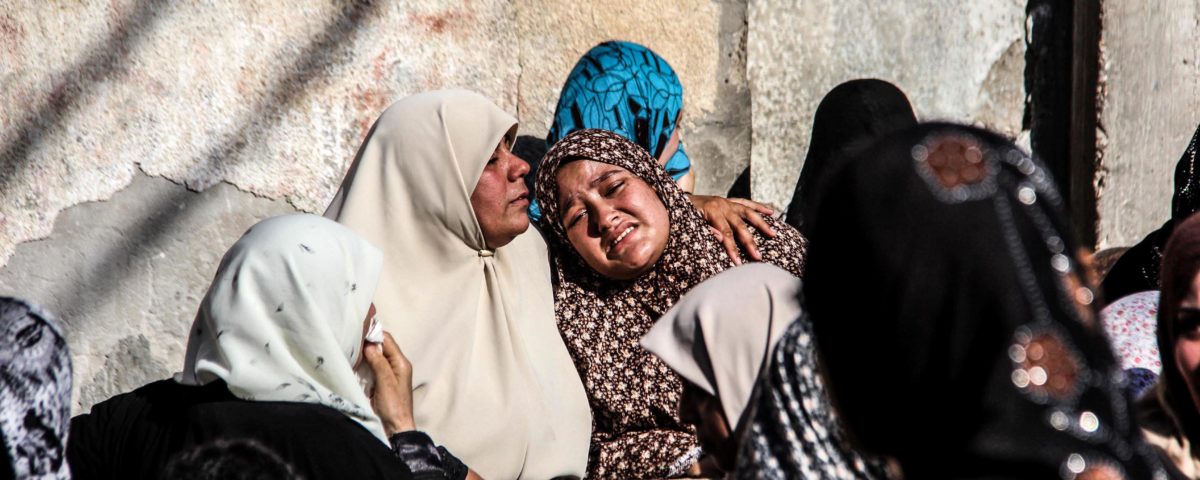Photo: @Samar Abu Elouf
Two years ago today, on July 7, 2014, the Israeli government launched a horrific 51-day air, land and sea attack on the people of Gaza. Israeli Defense Forces (IDF) fired missiles, rockets, artillery and tank shells relentlessly on 1.8 million Palestinians squashed by Israeli land and sea blockades into a narrow strip 25 miles long and five miles wide, one of the most densely populated places in the world. Nearly 500 Palestinians were killed by Israeli assassin drones.
Drone warfare has become the norm for both the United States and Israel. Drones fly above Gaza 24 hours a day watching the movements of every Palestinian and ready to fire rockets at those chosen to die by the IDF.
Al Mezan Center for Human Rights documents that, from 2008 until October 2013, out of 2,269 Palestinians killed by Israel, 911 were killed by drones, most during the 2008-2009 Operation Cast Lead. In the 2012 Operation Pillar of Defense, 143 out of 171 Palestinians killed by Israel were by drone attack.
In the 2014 Israeli attack on Gaza, the Al Mezan Center for Human Rights documents 497 Palestinians killed by drones, 32 percent of Palestinian deaths.
At the end of the 51 days, 2,310 Palestinians had been killed, 10,600 wounded, including 3,300 children; 872 homes were totally destroyed or severely damaged, and the homes of 5,005 families were damaged but still inhabitable; 138 schools were damaged or destroyed, 26 hospitals and health facilities were damaged. According to the United Nations Office for the Coordination of Humanitarian Affairs (OCHA), over 273,000 Palestinians in the Gaza Strip had been displaced of whom 236,375 (over 11 percent of the Gazan population) were taking shelter in 88 United Nations schools.
Palestinian militias shot homemade rockets killing 66 Israeli soldiers, five Israeli civilians, including one child, and one Thai citizen in Israel.
The 51-day Israeli attack on Gaza should not be characterized as a war between opposing forces but rather as a massive one-sided attack on Palestinians made at the choosing of Israel with its overwhelming military air, sea and land forces backed up with endless military supplies and equipment from the United States, including the missile system called the “Iron Dome.”
Now two years after the Israeli attack on Gaza, tensions in the West Bank are exploding. Beginning in October 2015, a few West Bank Palestinian youth have forsaken non-violent confrontation with Israeli military and have taken up knives instead of rocks in the latest intifada against Israeli occupation and oppression, against the continued building of illegal settlements on Palestinian lands and against the imprisonment of hundreds of Palestinian youth. The use of knives against IDF soldiers has expanded to deaths of Israeli civilians as well, including a 13-year-old girl in her home. Thirty-four Israelis, two U.S. citizens, an Eritrean and a Sudanese have been killed in the knife, gun or car-ramming attacks, and 214 Palestinians have been killed by IDF soldiers during this period.
The potential for Israeli response/revenge to these knife attacks is great and would probably not be directed to just the West Bank, but also toward Gaza.
As with other conflicts, the stories of death and of survival of civilians trapped in merciless bombings and fighting should compel leaders to work to end conflicts, but seldom do.
A new book published two days ago on July 5, 2016 chronicles the 2014 IDF attack on Gaza and focuses on the psychological and physical destruction suffered by the people of Gaza by one particular weapon system — the assassin drone that killed 497 during the 2014 attack.
Palestinian writer Atef Abu Saif provides the day-by-day life of a family and a community under fire from an enemy in the sky -beginning with July 7, 2014- two years ago today.
“The Drone Eats With Me: A Gaza Diary” is a graphic description of life under fire and particularly with the assassin drone lurking in the sky 24 hours a day waiting for its next victim. “The drone keeps us company all night long. It’s whirring, whirring, whirring, whirring is incessant -as if it wants to remind us it’s there, it’s not going anywhere. It hangs just a little way above our heads.”
Atef writes the sound of the drones is close: “the noise of this new explosion subsides; it’s replaced by the inevitable whir of a drone, sounding so close it could be right beside us. It’s like it wants to join us for the evening and has pulled up an invisible chair.”
Atef describes his future during the 51-day attack: “Our fates are all in the hands of a drone operator in a military base somewhere just over the Israeli border. The operator looks at Gaza the way an unruly boy looks at the screen of a video game. He presses a button and might destroy an entire street. He might decide to terminate the life of someone walking along the pavement, or he might uproot a tree in an orchard that hasn’t yet borne fruit. The operator practices his aim at his own discretion, energized by the trust and power that has been put in his hands by his superiors.”
Ann Wright
Font: OpenEdNews

